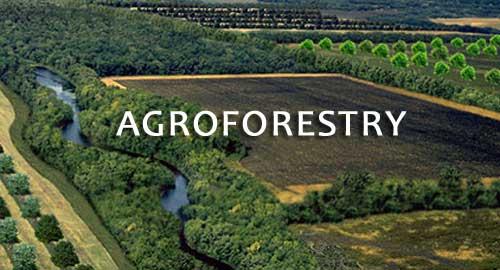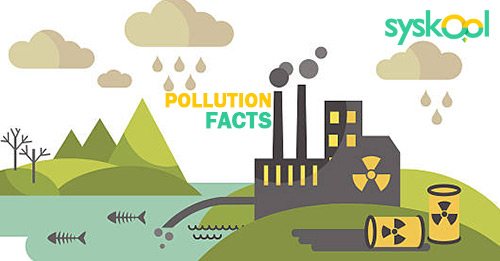Trees and
forest were always considered as an integral part of the Indian culture not only this but trees also play an important role in all terrestrials and provide a range of products and services to rural and urban people. As natural vegetation is cut for
agriculture and other types of development, the benefits that trees provide are best sustained by integrating trees into agricultural system — a practice known as agro-forestry.
Agro-forestry is an integrated approach of using the interactive benefits from combining trees and shrubs with crops and/or livestock. it combines agriculture and forest technologies to create more diverse, productive, profitable, healthy and sustainable land-use system.
Agro-forestry is basically a land management system but in recent years, its importance has been strongly felt for two reasons. Firstly, there is heavy pressure on agricultural land due to urbanization and secondly due to resource crunch agriculture is becoming unprofitable. Normally agro-forestry is a domain of agriculture where in crops the area is 80% or more and in trees, it is 20% or less. Though trees occupy very less area in it but plays the dominant role. In our country, greater emphasis is being given to agro-forestry but still it has not reached to the farmer as it should be, whereas in
China it has developed like an industry.
Scope Of Agro-forestry
Agro-forestry applies to private agricultural and forest lands and communities. These are highly disturbed human-dominated land-use systems. Targets include highly-erodible, flood-prone, economically marginal and environmentally sensitive lands. The typical situation is agricultural, where trees are added to create desired benefits. Our goal is to restore essential processes needed for ecosystem health and sustainability, rather than to restore natural ecosystems. Agro-forestry provides strong incentives for adoption of conservation practices and alternative land uses and supports a collaborative watershed analysis approach to management of landscapes containing mixed ownerships, vegetation types, and land uses.
Possible Impacts
• Controlling poverty through increased income by higher production of agro-forestry products for home consumption and market.
•
Food security by restoring farm soil fertility for food crops and production of fruits, vegetables, nuts and edible oils.
• Empowerment to women farmers and other less-advantaged rural residents whose rights to land are insecure through better negotiations.
• Reducing deforestation and pressure on the forest by providing fuelwood grown on farms.
• Increasing the buffering capacity of farmers against the effects of global climate change on-farm tree
crops and tree cover.
• Improving soil health of the farm through ameliorated micro-climate and nutrition level.
• Augmenting accessibility to medicinal trees for the cure of common and complex diseases.
Significance of Agro-forestry
Agroforestry provides a different land use option, compared with traditional arable and forestry systems. It makes use of the complimentarily relationship between trees and
crops so that the available resources can be effectively utilized. It is a practice that supports the environment and has an obvious landscape benefit. Efficient, modern versions of agroforestry have been developed, that are adapted to the constraints imposed by mechanization. The agroforestry plot remains productive for the farmer and generates continuous revenue, which is not feasible in arable land. Agroforestry allows for the diversification of farm activities and makes better use of environmental resources. Owing to increase in the population of human and cattle, there is increasing demand of food as well as fodder, particularly in developing countries like India. Each year farmers of the world must now attempt to feed 81 million more people irrespective of the weather. It is important to note that there will be 19% decline in cropland per head by the end of this century due to the population explosion. Therefore, there is slight scope to increase food production by increasing the area under cultivation. A management system, therefore, needs to be devised that is capable of producing food from marginal agricultural land and is also capable of maintaining and improving the quality of producing environment.
Agro-forestry has interesting advantages from three different perspectives.
From the agriculture perspective:
1. Diversification of the activities of arable farmers, with the building-up of an inheritance of multi-purpose trees, with continuous revenue from the farm.
2. Protection of intercrops and animals by the trees, which have a windbreak effect, providing shelter from the sun, rain, wind, soil erosion and stimulating
soil microfauna and microflora.
3. Recycling of some of the leached or drained nutrients by the deep roots of the trees; enrichment of the soil organic matter by tree litter and by the residue of the trees.
4. The possibility of combining the interest of the farmer (for an inheritance of wood) and the farm (for access to cultivated land). Possible increased remuneration for the arable farmer for the trees.
5. An alternative to full reforestation of arable land, permitting the continuation of arable activity on land whose arable potential otherwise is conserved. The tree component can be reversed, the plot stays “clean” (free from scrub) and is easy to destump when the trees are clear felled (the stumps are in lines and few in number).
6. In silvipastoral plots, fodder units can be available at different periods compared to full cropped plots, extending the grazing calender.
Also, Read: India Losing 135 Hectares Of Forest On A Daily Basis
From the forestry perspective:
1. Enhancement in the biomass growth of the trees by wide spacing (+80% over 6 years in the majority of the experimental plantations). A large reduction in the maintenance costs of the plantation, due to the presence of the intercrops.
2. Improvement in the quality of wood produced (wide regular rings, suited to the needs of the
industry), because the trees are not subjected to cycles of competition and thinning.
3. Guaranteed follow-up and tree care due to the arable intercropping activity. In particular, protection against the risk of fire in susceptible areas, with pasture or with intercrops like vine or winter cereals (clear bare ground in summer after stubble plowing).
4. Agroforestry plantations on arable land allow the development of a quality wood resource that complements, rather than competes with, the products from traditionally exploited forests. It is especially important to produce wood that can substitute for tropical saw logs, which will soon decline in availability and quality. The areas concerned will remain small in terms of their absolute value, but the production of wood from them could become a critical input to the European wood supply network. Tree species that are little used in forestry, but are of high value, could be grown in agroforestry systems: service trees, pear trees, common sorbs, walnut trees, wild cherry trees, maple trees, tulip trees, paulownias, etc…
From the environmental perspective:
1. Improvement to the development of natural resources: the total wood and arable production from an agro-forestry plot is greater than the separate production obtained by an arable-forest separate cropping pattern on the same area of land. This effect results from the stimulation of complementarity between trees and crops on agroforestry plots. Thus, weeds, which are spontaneously present in young forestry plantations, are replaced by harvested crops or pasture; maintenance is less costly and environmental resources are better used.
2. Better control of cultivated areas of land: by substituting for arable plots, the agroforestry plots contribute to diminishing the cultivated area of land. The intensification of environmental resource use by agroforestry systems is not resulting in more crop products.
3. Creation of original landscapes that are attractive opens and favor recreational activities. Agroforestry plots have a truly innovative landscaping potential, and would improve the public image of farmers to society. This will be particularly the case in very sparsely wooded areas, where plots are developed by planting arable land, and in very heavily wooded areas, where plots are developed by thinning the existing forest.
4. Counteract the greenhouse effect: constitution of an effective system for carbon sequestration, by combining the maintenance of the stock of organic material in the soil (the case especially with meadows), and the superimposition of a net fixing wooded layer.
5. Protection of soil and water, in particular in sensitive areas.
6. Improvement of biodiversity, especially by the abundance of “edge effects”. This, in particular, permits a synergistic improvement by favoring the habitat of the game. The integrated protection of crops by their association with trees, chosen to stimulate the hyper-parasite (parasites of parasites) population of crops, is a promising way forward.
7. These favorable characteristics are as coherent with the many objectives of the laws guiding agriculture and forestry, as they are with the directing principles of the Common Agricultural Policy.
Don’t Miss: Agriculture in India: Challenges with Agricultural Marketing and APMC Act
Benefits from Agro-forestry
Environment Benefits: Combining trees with food crops on cropland farms yield certain important environment benefits, both general ecological benefits and specific on-site benefits. The general ecological benefits include:
1. Reduction of pressure on forests.
2. More efficient recycling of the nutrients by deep-rooted trees on the site.
3. Better protection of ecological systems.
4. Reduction of surface run-off, nutrient leaching, and soil erosion through the impending effect of tree roots and stems of these processes.
5. Improvement of micro-climate, such as lowering of soil surface temperature and reduction of evaporation of soil moisture through a combination of mulching and shading.
6. The Increment in soil nutrients through addition and decomposition of litter-fall.
7. Improvement of soil structure through the constant addition of organic matter from decomposed litter.
Economic Benefits: Agro-forestry systems on croplands/farmlands bring significant economic benefits to the farmer, the community, the region or the nation. Such benefits may include:
1. Increment in maintenance of outputs of food, fuelwood, fodder, fertilizer and timber;
2. Reduction in incidence of total crop failure, common to single cropping or mono-culture system; and
3. Increase in level of farms incomes due to improved and sustained productivity.
Social Benefits: Besides the economics benefits, social benefits occur from the increase in crop and tree product yields and in the sustainability of these products. These benefits include:
1. Improvement in rural living standards from sustained employment and higher incomes;
2. Improvement in nutrition and health due to increased quality and diversity of food outputs; and
3. Stabilization and improvement of upland communities through the elimination of the need to shift sites of farm activities.
Limitations of Agro-forestry
An integrated food-tree farming system, while advantageous, does have certain negative aspects.
Environment Aspects:
(i) possible competition of trees with food crops for space, sunlight, moisture and nutrients which may reduce food crop yield;
(ii) damage to food crop during tree harvest operation;
(iii) The potential of trees to serve as hosts to insect pests that are harmful to food crops; and
(iv) rapid regeneration by prolific trees, which may displace food crops and take over entire fields.
Socioeconomic Aspects:
(i) Requirement for more labor inputs, which may cause scarcity at times in other farm activities;
(ii) Competition between food and tree crops, which could cause aggregate yields to be lower than those of a single crop;
(iii) Longer period required for trees to grow to maturity and acquire an economic value;
(iv) Resistance by farmers to displace food crops with trees, especially where land is scarce; and
(v) The fact that agroforestry is more complex, less well understood and more difficult to apply, compared to single-crop farm.
Through skillful management practices, any or all of these aspects can be controlled. For example, once it is easy to adopt some or all of the following strategies:
(i) Select legume trees that have small or light crowns so that sufficient sunlight will reach the food crop for photosynthesis;
(ii) Select tree species that are deep-rooted so that they will absorb moisture and nutrias from the surface layer of the soil; and
(iii) Space the trees farther apart to reduce their competitive effects on the food crops.
Have a look at:
Monsoon, Floods, and Droughts
Wildlife Corridors – Elephant Lifeline(s) – of Coimbatore
The Goods and Services Tax (GST)






